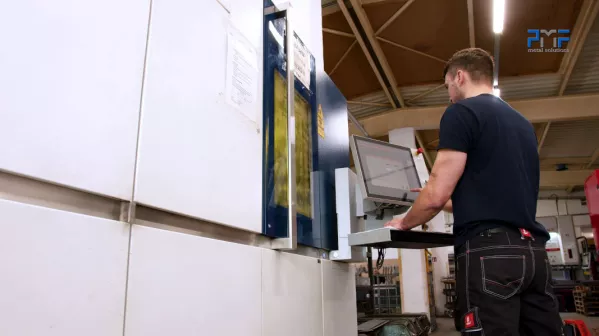+48 95 762 08 61
Modern technologies of metal working
Laser beam cutting
Laser cutting of tubes and sections
Robotic welding
Sheet metal bending
Laser beam cutting
Laser cutting of tubes and sections
Robotic welding
Sheet metal bending

Fiber laser cutting machines, also known as fiber lasers, are modern metal processing devices that use light energy to precisely cut materials. Fiber laser technology, unlike traditional CO2 lasers, is distinguished by its exceptional efficiency, stability, and precision. One of the market leaders is the Trumpf brand, whose fiber-based laser cutting machines are equipped with a TruDisk source with 6 kW power, ensuring high cutting power and reliability.
The foundation of a fiber laser cutting machine is the laser source, which generates a high-energy light beam. In fiber technology, as used in Trumpf's machines, disk lasers known as TruDisk are employed. The laser radiation is created by exciting electrons in special materials, such as doped fibers or crystals. In TruDisk 6 kW lasers, the excitation system is based on optical fibers, allowing for a stable, precise, and highly concentrated light beam.
In fiber technology, laser radiation is transmitted through a fiber optic cable. The use of fiber optics offers significant advantages compared to traditional mirrors and lenses used in older technologies, such as CO2 lasers. Energy transmission via fiber allows for better device flexibility and lower energy losses, which leads to greater cutting efficiency.
One of the key elements of the laser cutting process is focusing the laser beam on the material's surface. The high-power beam is concentrated in a small area, reaching temperatures sufficient to melt or even vaporize the material instantly. Thanks to precise focusing, laser cutting is highly accurate, allowing for the creation of complex shapes with minimal deviations.
When the laser beam focuses on the material's surface, the light energy transforms into heat, causing local melting of the material. A stream of technical gas (usually nitrogen or oxygen) is used to blow the molten material out of the cutting area, ensuring clean and smooth edges. Thanks to this technology, fiber laser cutting machines can cut various metals, such as carbon steel, stainless steel, aluminum, and others, with high precision and speed.
Fiber lasers like the TruDisk 6 kW offer significantly higher efficiency compared to traditional CO2 lasers. The high power allows for cutting thicker materials and faster processing, greatly improving productivity. Additionally, fiber lasers consume less energy, reducing operational costs.
Thanks to the extremely precise control of the laser beam, fiber laser cutting machines can produce details with accuracy down to hundredths of a millimeter. This is crucial when producing complex components where the highest finishing quality is required.
Fiber technology features fewer moving parts and does not require expensive mirrors or lenses. Fiber optics are durable and have a longer lifespan, leading to lower maintenance and repair costs.
Fiber laser cutting machines can be used to cut a wide range of materials, including non-ferrous metals, which are more challenging to process with traditional CO2 lasers. Additionally, fiber technology allows for cutting both thin and thick sheets with the same precision.
Fiber lasers like the TruDisk 6 kW are widely used in various industries, including:
Thanks to their versatility and high efficiency, fiber lasers are becoming increasingly popular in modern production facilities like Pro Metal Form, which prioritize innovation and efficiency in metal processing.
Fiber laser cutting machines in fiber technology, such as the Trumpf TruDisk 6 kW, are advanced technological tools enabling precise metal processing. Their operating principle is based on generating high-energy light, which is then transmitted through fiber optics and focused on the material surface, leading to local melting and precise cutting. Fiber lasers offer numerous advantages, including efficiency, precision, low maintenance costs, and broad application possibilities, making them essential tools in modern production processes.
This technology, successfully implemented at Pro Metal Form, enables the achievement of the highest standards of quality and efficiency, meeting the needs of the most demanding clients.